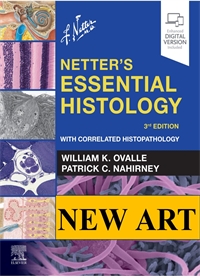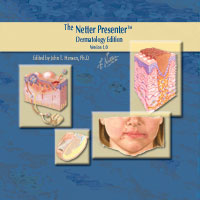Tropical Dermatology
Author: Stephen K. Tyring MD PhD MBA, Omar Lupi MD MSc PhD, Ulrich R. Hengge MD MBA
ISBN: 9780443067907

Introduction
Protozoa
- Page 43: Cutaneous leishmaniasis
- Page 44: Disseminated papules
- Page 44: Sarcoid-like lesion on the trunk
- Page 44: Lymphangitic leishmaniasis
- Page 44: Thousands of pustules
- Page 45: Grossly granular vegetation on the palate
- Page 45: Hypertrophic cheilitis
- Page 46: Giemsa stain of smear
- Page 46: Hematoxylin and eosin section of skin
- Page 51: Classical plaque on the dorsum of the nose
- Page 51: Similar lesion in a younger patient
- Page 51: Typical progression of the lesion
- Page 51: Lesion on the chest
- Page 52: Superficial and deep, dense and diffuse, ill-defined granulomas
- Page 52: Two amebas seen in skin tissue
- Page 53: A trophozoite seen next to the epidermis
- Page 53: A sagittal section of brain
- Page 53: Brain section stained with hematoxylin and eosin
Helminths
- Page 63: Life cycle of Onchocerca volvulus
- Page 64: Chronic papular onchodermatitis
Viral Infections
- Page 96: Structure of human immunodeficiency virus type 1 (HIV-1)
- Page 97: Life cycle of human immunodeficiency virus (HIV)
- Page 98: Viral exanthema due to human immunodeficiency virus type 1 (HIV-1) seroconversion
- Page 99: Molluscum contagiosum
- Page 99: Oral candidiasis
- Page 99: Kaposi's sarcoma
- Page 99: Cytomegalovirus (CMV) retinitis
- Page 100: Cryptococcosis
- Page 100: Histoplasmosis
- Page 101: Bacillary angiomatosis
- Page 101: Herpes zoster
- Page 101: Hansen's disease (leprosy)
- Page 102: Cutaneous tuberculosis
- Page 103: Tuberculids
- Page 103: Penile tuberculosis
- Page 103: Tuberculous dactilytis right fifth toe with warts (HPV infection)
- Page 103: Tuberculosis of cervical lymph node
- Page 103: Tuberculoma
- Page 104: Amebiasis cutis
- Page 104: Toxoplasmosis of the brain
- Page 105: Secondary syphilis
- Page 105: Anogenital herpes simplex
- Page 106: Carcinoma of the penis
- Page 106: Giant condyloma accuminata on the vulva
- Page 106: Non-Hodgkin's lymphoma
- Page 109: Dermatophytosis
- Page 109: Tinea versicolor
- Page 109: Penicilliosis
- Page 110: Bartholin gland abscess
- Page 110: Pyoderma
- Page 111: Nocardiosis
- Page 111: Leishmaniasis
- Page 112: Psoriasis
- Page 113: Reiter's disease
- Page 113: Ichthyosis
- Page 114: Eosinophilic folliculitis
- Page 114: Stevens–Johnson syndrome
- Page 115: Drug reaction due to nevirapine
- Page 115: Parotid gland enlargement in sicca syndrome
- Page 116: Immune complex vasculitis
- Page 116: Vascular ulcer
- Page 117: Photosensitivity
- Page 117: Addisonian pigmentation of tongue and nails
- Page 121: Lipohypertrophy (buffalo hump)
- Page 121: Lipoatrophy of the face
- Page 128: Macular, papular centripetal rash of Ebola infection
- Page 134: Distribution of New-World arenaviruses
- Page 135: Distribution of hantaviruses worldwide
- Page 137: Dengue distribution worldwide
- Page 138: Risk Factors for DHF/DSS: and integral hypothesis
- Page 140: Dengue hemorrhagic fever grade III
- Page 143: Jaundice due to yellow fever
- Page 147: Clinical evolution of smallpox
- Page 149: Smallpox: initial rash
- Page 152: Smallpox: day 3 (vesicles)
- Page 153: Smallpox: uniform vesicular eruption
- Page 153: Smallpox: vesicular umbilicated lesions on the sole
- Page 153: Smallpox: Day 5; uniform pustular eruption
- Page 153: Smallpox: depigmented scars after loss of crusts
- Page 154: Smallpox: scarring after convalescence
- Page 154: Complicated smallpox: flat hyporeactive smallpox
- Page 154: Complicated smallpox: early hemorrhagic smallpox
- Page 154: Complicated smallpox: early hemorrhagic smallpox
- Page 154: Complicated smallpox: early hemorrhagic smallpox
- Page 154: Complicated smallpox: late hemorrhagic smallpox
- Page 155: Complicated smallpox: massive excretion of poxviruses
- Page 155: Electron microscopy of an orthopoxvirus (vaccinia virus)
- Page 155: Positive reaction at vaccine in occulation site
- Page 156: Abortive smallpox after vaccination during incubation
- Page 156: Exacerbated reaction to smallpox vaccination
- Page 157: Eczema vaccinatum in a grandmother (with atopic dermatitis)
Fungal Infections
- Page 199: Lesion on right heel
- Page 199: Lesion on posterior thigh with gummata
- Page 200: Hematoxylin and eosin (H&E)-stained histopathology
- Page 200: Grocott-stained histopathology of skin
- Page 202: Sporotrichosis: fixed cutaneous form
- Page 202: Sporotrichosis: fixed cutaneous form
- Page 202: Asteroid body within a microabscess
- Page 203: Sporotrix schenckii
- Page 205: Verrucous and cicatricial lesions
- Page 205: Cluster of muriform cells of chromoblastomycosis
- Page 207: Red-to-purple, soft, vascular, and lobulated lesion
- Page 207: Rhinosporidiosis
- Page 209: Infiltrated and keloidal lesions of lobomycosis
- Page 209: Lobomycosis
- Page 209: Lacazia loboi
- Page 212: Zygomycosis: mucormycosis, rhinocerebral form
- Page 212: Zygomycosis: entomophthoromycosis, basidiobolomycosis
- Page 212: Zygomycosis: mucormycosis
- Page 217: Histoplasmosis: reactivation disease
- Page 217: Histoplasmosis: demonstration of yeast cells of Histoplasma
- Page 217: Histoplasmosis: agar slide culture
- Page 221: Spherules and endospores of Coccidioides immitis in lung tissue
- Page 224: Potassium hydroxide preparation of lung tissue
- Page 226: Paracoccidioides brasiliensis
- Page 227: Disseminated adenopathy
- Page 227: Paracoccidioidomycosis
- Page 227: Moriform stomatitis and verrucous lesions
- Page 228: Massive dissemination of paracoccidiodomycosis
- Page 228: Hematogenous dissemination
- Page 229: Extensive lesions of paracoccidiodomycosis
- Page 229: Regression of cutaneous and visceral lesions
- Page 230: Cutaneous lesions
Bacterial Infections
- Page 243: Impetigo contagiosa
- Page 243: Tinea in the face complicated by impetigo
- Page 244: Folliculitis
- Page 244: Numerous small folliculitis lesions
- Page 245: Highly inflammatory abscess in the neck
- Page 245: Ecthyma caused by Streptococcus pyogenes
- Page 246: Rapidly expanding erythema with epidermolysis
- Page 246: Necrotizing deep ulcerations and blisters
- Page 248: Purulent necrotizing fasciitis
- Page 252: Tuberculous colliquativa cutis
- Page 252: Ulcerated scrofuloderma
- Page 253: Hypertrophic scars of scrofuloderma
- Page 253: Erythema induratum
- Page 254: Mycobacterium tuberculosis
- Page 254: Papulonecrotic tuberculids
- Page 257: The nine-banded armadillo
- Page 260: The immunologic spectrum of leprosy
- Page 260: The Ridley-Jopling classification
- Page 264: Leontine facies after longstanding lepromatous leprosy
- Page 265: Saddle-nose deformity
- Page 266: Lagophthalmos
- Page 267: Opacity and blindness
- Page 269: The sites at which peripheral nerves are most commonly palpable in leprosy
- Page 305: Miliary type of verruga peruana
- Page 305: Mular type of verruga peruana
- Page 306: Another verruga peruana, mular type
- Page 306: Verruga peruana
- Page 306: Higher power showing the vascular proliferation
- Page 306: Verruga peruana mimicking lymphoma
- Page 307: A more sarcomatous , spindle-cell pattern of verruga peruana
- Page 307: Solid, spindle-cell pattern of verruga peruana
- Page 307: Verruga peruana mimicking lymphoma
- Page 308: Bacillary angiomatosis, angiomatous type
- Page 308: Bacillary angiomatosis on elbow
- Page 308: Bacillary angiomatosis, verrucous type
- Page 309: Bacillary angiomatosis: lobular pattern
- Page 309: Bacillary angiomatosis: vascular pattern with septa
- Page 309: Bacillary angiomatosis: the pattern of vascular proliferation
- Page 310: Bacillary angiomatosis: nuclear dust and interstitial purple material
- Page 310: Aggregates of bacilli
- Page 311: Cat-scratch disease
- Page 314: Circinate balanitis
- Page 314: Keratoderma blennorrhagicum (Reiter's syndrome)
- Page 314: Lymphogranuloma venereum with massive inguinal lymphadenopathy
- Page 315: Bubo with spontaneous fistulization
- Page 315: Later stage of lymphogranuloma venereum with perianal fistulas
- Page 315: Staining of the smear (Giemsa, 400x)
- Page 317: Severe sequel of neonatal ophthalmia
- Page 318: Typical clinical picture of purulent urethritis by gonococci
- Page 318: Urethritis together with gonococcal balanoposthitis
- Page 318: Urethritis together with gonococcal balanoposthitis
- Page 318: Patient with ulcerated balanoposthitis
- Page 318: Gonococcal urethritis and fungal balanitis
- Page 319: Gonococcal vulvitis in a child victim of sexual abuse
- Page 319: Patient with orchiepididymitis as a complication of gonococcal urethritis
- Page 319: Gonococcal dermatitis
- Page 320: Patient with gonococcal arthritis
- Page 320: Presence of various Gram-negative intracellular reniform diplococci
- Page 323: Chancroid
- Page 323: Chancroid
- Page 323: Chancroid
- Page 330: Primary syphilis or chancre
- Page 330: Secondary syphilis: roseola syphilitica
- Page 331: Secondary syphilis: disseminated papular lesions
- Page 331: Secondary syphilis: papular and nodular lesions
- Page 331: Close-up of figure 26.32
- Page 331: Secondary syphilis : annular lesions
- Page 332: Secondary syphilis: hyperkeratotic lesions on palms and soles
- Page 332: Secondary syphilis: hyperkeratotic and squamous lesions, resembling tinea
- Page 333: Secondary syphilis: Biet's collaret on palms
- Page 333: Secondary syphilis: condylomata lata on the perianal area
- Page 333: Secondary syphilis: patches of alopecia
- Page 334: Congenital syphilis: syphilitic pemphigus
- Page 334: Congenital syphilis: same patient as in figure 26.40
- Page 336: Pinta: transmission of pinta via direct contact with an infected person
- Page 337: Pinta: primary stage
- Page 337: Pinta: period of cutaneous dissemination
- Page 337: Pinta: hyperchromic, hypochromic, and achromic patches
- Page 338: Pinta: hyperkeratosis, and achromic lesions
- Page 338: Pinta: Hyperchromic and hyperkeratotic patches on the palmar surface. Hyperkeratotic areas on the plantar surface.
- Page 338: Pinta: presence of treponeme on the epidermis
- Page 362: An eschar and local facial carbuncle resulting from the bite of a Yersinia pestis-infected flea
- Page 362: A bubo of the femoral lymph nodes in a patient with bubonic plague
- Page 368: Endemic areas for Trachoma
- Page 370: Follicular conjunctivitis (FT)
- Page 370: Intense, diffuse inflammation (TI) with papillary hypertrophy
- Page 370: Linear and stellate scarring of upper eyelid tarsus (TS)
- Page 370: Trichiasis (TT) and cicatricial entropion of upper eyelid
- Page 371: Corneal opacity (CO) from superficial fibrovascular pannus involving visual axis
Ectoparasitic Diseases
- Page 376: Female scabies mite with eggs
- Page 377: Life cycle of scabies
- Page 378: Papular vesicular and croded lesions
- Page 378: Papular lesions
- Page 379: Section through a burrow showing mite parts
- Page 379: Scabies of the hand
- Page 379: Scabies with secondary streptococcal infection
- Page 379: Scabies with secondary infection – elbow
- Page 380: Crusted scabies of the elbow – immunosuppressed patient
- Page 380: Same patient as in Figure 29.9
- Page 380: Crusted scabies in a patient with leprosy
- Page 380: Crusted scabies of the hand and wrist
- Page 380: Crusted scabies of the shoulder
- Page 381: Fatal crusted scabies
- Page 381: Severe crusted scabies with fissuring involving the leg
- Page 381: Skin biopsy of a fatal case of crusted scabies
- Page 382: Presumptive treatment of scabies algorithm
- Page 388: Immersion oil mount of a head louse
- Page 388: Head louse nit attached to a hair shaft.
- Page 389: Identifying characteristics of a crab louse.
- Page 389: Crab louse nits
- Page 389: Hair casts
- Page 389: Microscopic mount of a pseudonit (hair cast)
- Page 391: Immersion oil mount of a crab louse
- Page 394: Adult fly of Dermatobia hominis
- Page 394: Dermatobia hominis larvae
- Page 395: Adult fly of Cochliomyia hominivorax
- Page 396: Furunculoid myiasis of the scalp
- Page 396: Furunculoid myiasis of the scalp
- Page 397: Furunculoid myiasis of the scalp
- Page 397: Wound myiasis caused by Cochliomyia hominivorax
- Page 407: Kwashiorkor
- Page 408: Marasmus
- Page 410: Vitamin A deficiency. Perifollicular hyperkeratosis on the arm.
- Page 423: Localized form of fogo selvagem
- Page 424: Generalized fogo selvagem, vesiculobullous form
- Page 424: Generalized fogo selvagem and herpes simplex infection
- Page 424: Generalized fogo selvagem, exfoliative erythrodermic form
- Page 425: Generalized fogo selvagem, keratotic form
- Page 425: Fogo selvagem, hyperpigmented form
- Page 431: Tinea versicolor of the face
- Page 431: Widespread pityriasis alba with prominent follicular keratosis
- Page 432: Transient postlesional hypochromia
- Page 432: Trichrome vitiligo
- Page 433: Borderline lepromatous leprosy
- Page 433: Creole dyschromia
- Page 434: Systemic sclerosis with typical punctuated achromia
- Page 434: Hypopigmented variant of sarcoidosis
- Page 435: Lichen planus with prominent associated hyperchromia
- Page 436: Fixed drug eruption at various stages
- Page 436: Exogenous ochronosis in a long-standing user of hydroquinone-based bleaching products
- Page 436: Typical palmar pigmenting papular lesions of secondary syphilis
- Page 437: ""Blue nails"" associated with human immunodeficiency virus (HIV) infection
- Page 438: Late-stage malignant melanoma of the sole
- Page 442: Severe case of phototoxic dermatitis
- Page 442: Aroeira (Lithraeae brasiliensis)
- Page 442: Contact dermatitis
- Page 443: Chronic case of contact dermatitis due to aroeira
- Page 444: Contact dermatitis due to plants with a mild acanthosis
- Page 446: Tropical rat mite
- Page 447: Chigger bites
- Page 448: Rickettsial eschar
- Page 450: Fire ant stings
- Page 451: Tropical bedbug
- Page 451: Triatome bug
- Page 452: Blister beetles
- Page 452: Pulex irritans
- Page 454: Centipede jaws
- Page 454: Centipede bite
- Page 454: Millipede
- Page 460: Papules and vesicles resulting from exposure to the tentacles of Chrysaora plocamia
- Page 463: Conus textile, the poisonous cone shell
- Page 464: Octopus lunulatus
- Page 464: The beak of an octopus
- Page 464: Radiograph of the hand of a patient who experienced a puncture wound from a catfish
- Page 464: Serrassalmus spilopleura, the piranha
- Page 465: A stingray
- Page 465: Freshwater stingrays
- Page 465: Serrated barbs of a marine stingray
- Page 466: Hemorrhagic effects of a weeverfish sting
- Page 466: Scorpaena plumieri, the scorpionfish
- Page 466: A stonefish








